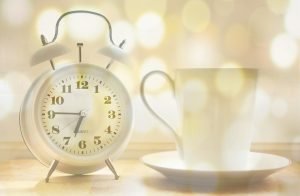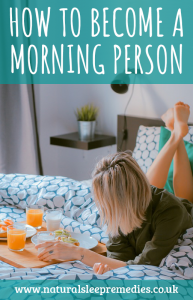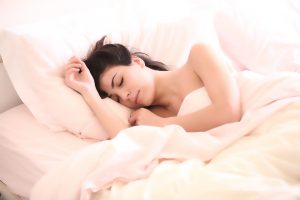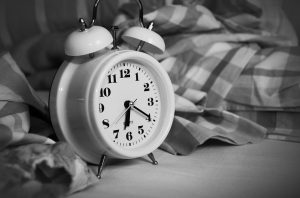Update: I have collated all the information in this article, and much more, into my new article series How I Overcame Insomnia in 10 Steps

Insomnia comes in many different forms. Some people have a sleepless night once in a while when they are worried about something. Others have sleepless periods which can go on for weeks or even months at a time. And others have recurring insomnia that plagues them for years.
Some people have difficulty falling asleep, while others keep waking up in the night. Others seem incapable of sleeping at night, yet are passed out cold for the whole day. For some people, insomnia is caused by an inability to shut off the mind – worry, anxiety, grief, or depression. For others, physical pain is the reason they can’t sleep – either acute pain from an injury or illness, or chronic pain from arthritis, fibromyalgia, and other conditions.
Still others find that hormonal changes at different times of life can affect their ability to get enough sleep, such as pregnancy or the menopause in women, or prostate issues in men. Other cases are caused by a disrupted sleeping pattern, such as shift work, jet lag, parenting (newborns especially, but kids can keep you up at night at any age!), working late night to get an undergrad essay in… I could go on and on!
Since there are so many different causes and manifestations of insomnia, it seems absurd to treat them all in the same way. But this is precisely what most doctors do when they prescribe sedatives to patients suffering from insomnia. In addition, prescription sleeping pills are often addictive, don’t produce good quality sleep, and come with their own list of side effects which are frequently worse than the insomnia itself.
Prescription or Natural?
These issues can mean that people end up dependent on prescription medications, and other meds to address side effects, without ever actually treating the root cause of the insomnia.
Don’t get me wrong, there is a time and a place for prescription sedatives – particularly in cases of severe injury, some cancers, and for people suffering serious grief or depression. In such cases strong medication can help someone get required sleep under extremely difficult circumstances, when otherwise they may not be able to do so.
However the vast majority of cases of insomnia are caused by less severe problems and it is often possible, and preferable, to treat these naturally rather than introducing an addictive pharmaceutical into the mix. This is why a lot of people are turning to natural sleep remedies instead of prescription sleeping pills, and learning how to treat insomnia naturally, at home, themselves.
When I think about my own experiences with insomnia, I find I have phases of insomnia that can last a couple of weeks to a few months. Mostly now, my phases don’t last any longer than a week and are less common. This is because I have established a better sleep routine (more on this further down), and have taken some steps to improve my sleep hygiene.
But there is still more I could do, and when a phase of insomnia hits me, I usually know what has caused it and what to do to address it. Part of learning to treat your own insomnia is simply understanding your triggers and responses, and having routines in place to deal with it when it occurs.
There are many, many different ways to treat insomnia without prescription medication. Some of these will work better for certain types of insomnia, and some just work differently for different people. It is definitely worth trying a few different methods, but make sure you give each one a good few weeks before writing it off. Some take a while to build up in the body (such as magnesium supplements and tryptophan-rich foods), and the body generally likes and responds better to consistent habits, which can sometimes take a few weeks or months to establish.
Routine
On the subject of habits, a big piece of the insomnia puzzle is ROUTINE. So the best advice for learning how to treat insomnia is to establish a nightly routine and stick to it as best you possibly can, over a long period of time. And the next biggest piece is learning what most affects YOU. Identifying your own triggers is key to developing a routine that works best for you, as you will only need to use the techniques and remedies that will have the greatest effect.
Over time, I discovered which techniques worked well for me, and I’ve described exactly what I did in my new article series How I Overcame Insomnia in 10 Steps.
Below is a list of methods, with information on how to implement them into your own life.
1. Set a Waking Up Time (and a Regular Bedtime)
This one is absolutely number 1 on the list for a good reason. There are two sides to this, and the morning is more important than the evening. Setting an alarm for the same time every single day, including weekends is the best way to train your body to wake up. The body does not like having an inconsistent routine. While we know that the working week runs from Monday to Friday, and the weekend is our chance to catch up on sleep, our bodies do not work like this. The body will very quickly settle into a new routine, provided you are consistent.
I know how difficult that is, by the way. There is something that makes you feel a bit cheated about getting up early on a weekend, but remember: once you’ve had a shower and woken up properly, you will feel absolutely fine, and then you will feel pleased with yourself that you’ve added a couple of extra hours to your day to get things done. Even if you’ve had a really bad night, you must still get up at your alarm, even if you feel like a zombie. The more consistent you are, the quicker your body will adapt.
The other side of the set-times routine is of course getting to bed at around the same time every night. There are a few more considerations when setting a bedtime, so don’t be as strict when setting a bedtime.
The first recommendation is not to go to bed when you’re not feeling tired. Insomnia can be habit-forming in the sense that after a few weeks of lying in bed awake, the body begins to associate bed with anxiety and lying awake. This is the rationale behind the advice to get out of bed if you’re not falling asleep (more on this later).
If you often go to bed at 11pm but find yourself lying awake until 1am, try setting a bedtime at 1am instead. You may find that you drop off more easily, because you’re so much more tired. If you stick fairly firmly to a 1am bedtime for a few weeks, you will find that it’s easier to gradually shift your bedtime once you have a regular routine in place.
The second recommendation is not to stay up “beyond tired”. I’m sure many of you will relate to the idea that if you fight the urge to go to bed when you are actually feeling tired, it is very easy to go “beyond tired” where you feel wide awake again.
Sometimes the tired feeling comes much earlier than you expect, and these are the times we often ignore our bodies and push on through. “I’m not going to bed at 9pm!” we tell ourselves indignantly, “the kids have only just gone to bed and I haven’t watched [insert current binge-watching series here] yet!”
There is actually a certain amount of merit to the need for some down-time before bed. If we put the kids to bed at 9pm and went straight to bed, we would feel like we hadn’t had any peace and quiet or me-time at all. Not only that, but many parents would never get anything done at all! The time between kids going to bed and parents going to bed is often the time used for basic household chores, admin stuff, and the only opportunity to spend time alone with their partner.
In this case I would argue that a bedtime even only an hour later than the kids will help, or implement a routine where your kids spend an hour or so upstairs reading quietly before lights out. A few things to consider there.
But for the most part, we need to be listening more closely to our bodies. Take a hint: if you start actually feeling tired and sleepy, STOP what you are doing and go to bed NOW! You can always pick it up again in the morning.
The third recommendation relating to bedtime is (unlike waking up) to not to be too rigid about a specific time. You need to balance your natural feeling of tiredness against the need to get a certain amount of sleep per night.
The obvious starting point is to count back 8 hours from your waking up time and aim for that, but as previously mentioned: you should be flexible enough to go to bed earlier if you find yourself yawning, or later if you’re still wide awake. Allow some variation either side of your target time, and be stricter about the mornings.
2. A Nightly Routine
This is an easy second place. Actually it’s kind of an extension of number 1, because it involves consistency and routine. In addition to a consistent TIME for sleeping, you also need to establish a consistent set of ACTIONS associated with sleeping. The body very quickly learns to use sights, sounds, smells and actions as cues for initiating its systems.

For the easiest example to evidence this, you simply have to imagine a freshly cut lemon to get your mouth to salivate. Imagine squeezing one half and feeling the sour juice trickle over your fingers. Your body associates a mental image of a lemon with the taste of a lemon, and sends a message to the salivary glands to start producing in readiness for that lemon slice you’re apparently about to eat.
The same is true of sleepiness. If you don’t really have a consistent way of going to sleep, how does your body really know when it is time to do so? Especially with all the artificial lighting and sensory overload and Netflix binge watching we have now in the 21st century – it’s tough for our bodies to know what in the world to do!
So give your body a hand. Create a nightly routine that you stick to, and after a few weeks your body will begin to respond by becoming sleepy almost as if on cue. It makes sense to incorporate relaxing activities into this routine – for example, include relaxing activities such as:
- A warm bath with soothing essential oils
- Gentle stretching such as yoga (but nothing that raises your heart rate or breaks a sweat)
- Self massage
- Meditation or quiet contemplation
- Reading a book
- A mug of warm milk, chamomile tea, or other soothing drink
Some activities actually work against the way the body works, and can disrupt the circadian clock which regulates sleeping. A prime example of this is the blue-spectrum light that emits from screen devices such as mobile phones, tablets, laptops and computer monitors.
Interestingly, TV does not affect us as badly. This is for two reasons: firstly the programs and films we watch are not filmed with a constant white background, but feature a range of different colours and often some darkness; secondly because watching TV is passive. By contrast, reading articles and interacting on social media are more mentally involved activities and can stimulate the mind rather than winding it down.
However, a word of caution about TV: try not to watch anything too exciting, stressful, emotionally upsetting or scary right before bed. Even though you’re not REALLY in a stressful situation, the simulation is often good enough to have your adrenal glands release cortisol which is responsible for keeping you alert and awake. Same goes for strenuous exercise; save it for earlier in the day.
So here’s a list of other activities to add to your nightly routine:
- Avoid using phones, tablets, laptops and computers for an hour before bed
- Or, if you must, install a blue-light filter on your device, if you can’t live without it!
- Read a paper book, or a non-backlit Kindle
- Dim artificial lighting, for example a floor lamp or table lamp in the living room, and a low wattage bedside lamp in the bedroom. The Lumie alarm clock is awesome for dim lighting.
- Watch a funny or uplifting movie or TV show, if TV helps you relax
- Avoid strenuous exercise (but gentle stretching is ok)
- Draw the curtains or blinds
- Write a diary – offloading worries, daily events and tomorrow’s to do list can help to let the mind relax at the end of the day
- Avoid caffeine products such as coffee, tea, chocolate, some soft drinks such as cola. Watch out with over the counter painkillers as some of these contain caffeine too. Avoid caffeine at least three hours before bed. Drink warm milk or chamomile tea instead.
- Avoid eating a heavy meal before bed
- Snack on tryptophan-rich foods such as nuts, bananas and dairy products, and easy to digest carbs such as fruit and biscuits.
- Visualisation (imagine your alarm going off in the morning, you waking up and getting out of bed, etc) just as you settle down in bed can really help with preparation for the next day and can aid your motivation in the morning.
The above examples are suggestions to add to your routine, but you should establish a routine with a few simple steps that suits you and your lifestyle.
A great little evening ritual I like is to close the curtains and dim the lights to mark the transition to evening. I have done this for years. The reverse of that is to open the curtains first thing in the morning (although this one sometimes gets put off on weekends!)
A nice bedtime routine to begin with is to take a mug of warm milk or chamomile tea to the bathroom, run a warm bath with lavender bath oil, then read in bed for half an hour to a dim bedside lamp. Start your routine an hour or so before you want to go to bed, and then switch off the light at your designated bed time and your body will have been prepared for an hour.
The more consistent you can be with your routine and timing, the quicker your body will adapt to the routine and begin responding by feeling sleepy.
3. Synchronise your Circadian Clock
The Circadian Clock is a daily hormonal cycle regulated by part of the hypothalamus in the brain. It is usually synchronised to the Earth’s natural cycle of darkness and light (rotational period) hence the Latin circa (‘about’) + diem (‘day’). It takes its cues from natural sunlight to keep it in check, but can fall out of kilter, especially in artificial light, and stressful events and environments.
The Circadian Clock regulates the production of melatonin (hormone promoting sleep) in the evenings, and cortisol (alertness hormone produced during exercise and stressful situations) in the mornings. For more information, read this article on the Circadian Clock.
If you regularly suffer from insomnia, chances are your Circadian Clock may be out of synchronisation with the Earth’s day/night cycle. This can be caused by shift work, jet lag, inconsistent sleeping and waking times, persistent late nights, stress, and a variety of other triggers.
There are a number of Circadian Rhythm disorders which can cause serious physical and psychological problems, however the majority of Circadian Clock disruptions are temporary and possible to fix by re-sychronising to the Earth’s natural cycle.
The part of the hypothalamus which regulates the Circadian Clock takes its cue from periods of natural bright sunlight, and periods of darkness. So the best way to synchronise your Circadian Clock is exposure to bright sunlight first thing in the morning and throughout the daytime, and dim lighting at night time.
If you’re lucky enough to live in a sunny country, get outside in the sunshine first thing in the morning to stimulate your hypothalamus to produce cortisol and inhibit melatonin.
However, if you live in a country which rains all the time (like I do), and you don’t get an awful lot of sunshine, it may be worth investing in an SAD lamp. These are very bright white-light lamps designed to mimic natural sunlight.
People who suffer from SAD (seasonal affective disorder) use the lamps to boost their mood in dark winter days, as a replacement for natural sunshine. They can also be used first thing in the morning (while you’re eating breakfast, perhaps) to stimulate the production of cortisol and inhibit the production of melatonin.
In addition to bright light therapy in the mornings/daytimes, the hypothalamus also needs regular periods of darkness to stimulate production of melatonin in the evening. If you do use an SAD lamp, be sure you do not use it after about 5pm! Otherwise it will have the opposite effect. After 5pm you should dim lighting inside the house.
Choose floor lamps over ceiling lamps, or install dimmer switches and turn the lights down a little in the evenings. Draw the curtains after the sun goes down.
The later into the evening, the dimmer the lights should be, and around 2-3 hours before you want to go to bed, you can start filtering blue-spectrum light. Blue-spectrum light is light with shorter wavelengths.
The sun produces light of all wavelengths, but in the evening, as the sun sets it is refracted in the atmosphere and filters out shorter wavelengths. This is why the sunset appears red and orange. To simulate this in your home, choose lights with a warmer tone (as opposed to very bright, white or bluish lights such as fluorescent lighting or SAD lamp light).
Incandescent (tungsten) light bulbs tend to emit a warmer tone, so you could use one of these in a floor or table lamp. Alternatively, lightbulbs with coloured glass can warm up the tone of fluorescent or LED lights. The key is low lighting rather than focusing too heavily on wavelength.
As previously mentioned, blue-light filters on screen devices in the evening can make a big difference if you regularly use a mobile phone, tablet or computer in the evenings. The bluish light emitted by devices such as these can simulate bright daylight in the hypothalamus and disrupt the Circadian Clock.
Make sure your bedroom is dark enough. Heavy, lined curtains or blackout blinds can eliminate any light from street lamps or early sunrise through the window. Many people also use an eyemask to block out any extra light.
Keep your bedside lamp very dim if possible. The Lumie Bodyclock Spark 100 alarm clock is perfect for this, as you can adjust the brightness from very bright SAD lamp brightness to very low light levels for the night time.
4. Insomnia Attack Routine
A good stable routine as outlined above will really help to get sleeping patterns back on track. But with the best will in the world, sleepless nights can and will occur. The best thing you can do when you have an “insomnia attack” is to be aware of your triggers and try to learn from your experiences.
Each time you find yourself having a sleepless night, try to identify what is keeping you up. Is it physical pain? Depression or grief? Anxiety, worry or panic? Has something upset you? Ask yourself these questions and maybe write down how you’re feeling. You can later look at what you’ve written and try to identify causes and triggers during the day.
Identifying our own triggers can help us to decide what to do the next time we can’t sleep. For example, if you are worried about something that is playing on your mind, it would be better to focus on something else to take your mind off it, like reading or watching a film, than to lie in bed with your thoughts echoing around your mind.
On the other hand, someone who finds it difficult to switch their brain off should avoid doing anything engaging like reading and work on learning to relax their mind instead, such as meditation.
Some sleep therapists recommend never lying in bed awake. They theorise that the more time spent in bed awake, the more likely the body will begin to associate the bed with lying awake and anxiety. Then the insomnia becomes a habit rather than a short term problem. They suggest getting up and out of bed if you are not able to sleep within a certain period of time.
However some sleep therapists disagree and argue that the action of getting up and out of bed increases the alertness and awakeness and makes dropping back off even harder.
I suspect the answer is different for each insomnia sufferer. Personally, I find that if I am too ready to get out of bed, I will just end up waking myself up even more. Plus I also associate getting up with a feeling of resignation – that if I have to get up, it’s like I’m admitting to myself that I’m not going to get any sleep at all tonight. I prefer to stay in bed and turn on a low light to read for a little while if I’m having trouble sleeping.
However I will get up if I have been tossing and turning for over 2 hours. Once I make that decision to get up, I don’t usually go back to bed. Mainly because I don’t want to disturb my partner any more than I have to, and getting out of bed is disturbing in the first place. I sometimes find that I can nod off on the sofa, but other times I end up doing something else, watching TV, reading or listening to a podcast for example.
I will usually make myself a warm drink (preferably caffeine free!) to sip while I snuggle up on the sofa. Because I am a sometimes-insomnia sufferer, I always keep soft cushions and a large, warm fleece blanket folded up on the sofa. It is large enough and warm enough to substitute a duvet if I find myself sleeping on the sofa.
So the key here is to find what works for you. Here’s a list of ideas, and notes on pros and cons:
- Counting down from 300 in increments of 3. Requires focus and helps to blot out other thoughts, but is boring enough to send you off to sleep. Less effective for those with over active imaginations or those who are easily distracted.
- Listening to music. There are lots of relaxing spa music or atmospheric music in different styles. It’s definitely worth looking around and trying a few different types. I like music with water sounds, bird sounds, pan pipes and flutes. You might prefer harp, or piano, or classical guitar. Some people prefer orchestral music, or opera, or their favourite 60s folk singer. Some people find music with lyrics to be too engaging, especially if it is a song they know very well. There is also music designed to stimulate sleep brainwaves, called Binaural music which you might want to try.
- Listening to a podcast or audiobook. If you find music too engaging, you could try listening to the spoken word instead. Pick a book or a podcast by someone with a calm, relaxing voice. Don’t listen to something you want to remember, because if you do fall asleep, you’ll miss half of it! Another good idea is listening to hypnotherapy tracks.
- Listening to white noise. If music and the spoken word keep your mind awake and active, but you like the idea of some background noise, try listening to a white noise track. This provides background sound and blocks out other sounds like clocks ticking or a snoring partner effectively.
- Reading with a very dim light. You don’t want to strain your eyes too much, but the light needs to be dim enough that reading is a bit of an effort. Eventually you’ll find your mind wandering and your eyelids drooping. You could read a non-backlit kindle instead of a book, or a tablet or mobile phone if you dim the screen and add a blue-light filter.
- Watch TV very quietly – choose something calm, comforting, nostalgic, witty, or uplifting. Some people find that having electronics such as TVs and computers in the bedroom distracts them from sleeping, while others prefer a TV for background noise. If you do have a TV, see if there is a setting that will turn it off for you after a couple of hours if you have fallen asleep. Having the TV on could wake you up in the middle of the night.
- Have a warm drink. Decaffeinated coffee or tea, warm milk, chamomile tea, other no-caffeine herbal teas, Ovaltine, hot chocolate, etc. A warm, sweet, milk-based drink has long been associated with going to bed, and helps to relax and soothe the stomach before going to sleep.
- Take an herbal supplement or tincture containing hops, passionflower, valerian and/or skullcap. Read more about natural insomnia remedies.
- Writing. Use a journal to write down why you’re sleepless, whether you’re upset, angry, scared, anxious, nervous, depressed, etc. Writing your feelings down can help to offload them from your mind and will provide you with a valuable insight into the patterns and triggers for your insomnia.
- Do something productive. If all else fails, and you know you’re not getting to sleep any time soon, bite the bullet and do something productive with your time. Get on with some work, wash the dishes, put on a load of laundry, pay some bills, etc. You may find that this tires you out enough to fall back to sleep after an hour or two. If not, well at least you’ve got something done in that time other than just sighing and turning over.
I hope this article has been useful in helping you to understand your own form of insomnia and to learn how to treat insomnia without prescription medication. I’m by no means a doctor, so I would always recommend that you speak to your doctor if you’re planning to come off prescription sleeping pills as some can have withdrawal side effects that may need to be managed.
Summary
- Set a strict morning wakeup alarm and stick to it on weekends
- Have a firm but flexible bedtime around 8 hours before your morning alarm
- Don’t go to bed until you’re tired (within reason) or stay up “beyond tired”
- Establish a regular bedtime routine including relaxation, dimming lights, avoiding screen devices, warm bath and warm milky drink.
- Synchronise your Circadian Clock using light therapy in the day time and adequate darkness at night.
- Have an Insomnia Routine including activities to do or avoid when having a sleepless night such as listening to music or a podcast, reading, watching TV, or even what to do if you definitely won’t sleep.
- And just to reiterate, STICK TO YOUR MORNING ALARM!
 There are morning people and there are night owls. That’s just the way it is. That’s what I’ve always thought, and this belief gets repeated again and again, by both parties.
There are morning people and there are night owls. That’s just the way it is. That’s what I’ve always thought, and this belief gets repeated again and again, by both parties. Pretty obvious, huh? Work back 8 hours from the time you’d like to get up and that’s your new bedtime. Work back another hour to give yourself time to establish a getting ready for bed routine to help your body feel settled before trying to sleep.
Pretty obvious, huh? Work back 8 hours from the time you’d like to get up and that’s your new bedtime. Work back another hour to give yourself time to establish a getting ready for bed routine to help your body feel settled before trying to sleep.


 Here’s an interesting term I hadn’t come across before until recently: sleep hygiene. It sounds very clinical but it’s not at all. It just means healthy sleeping practice. Most of the recommendations for good sleep hygiene are common sense, but if you’re anything like me, even if I know something is bad for me it doesn’t always stop me from doing it!
Here’s an interesting term I hadn’t come across before until recently: sleep hygiene. It sounds very clinical but it’s not at all. It just means healthy sleeping practice. Most of the recommendations for good sleep hygiene are common sense, but if you’re anything like me, even if I know something is bad for me it doesn’t always stop me from doing it! It seems obvious to say it, but avoiding stimulants later in the day really helps to wind your body and mind down for the evening before you go to bed. Stimulants can continue to act for several hours after you’ve taken them, so make sure you avoid caffeine after about 4 to 6 hours before you plan to go to bed.
It seems obvious to say it, but avoiding stimulants later in the day really helps to wind your body and mind down for the evening before you go to bed. Stimulants can continue to act for several hours after you’ve taken them, so make sure you avoid caffeine after about 4 to 6 hours before you plan to go to bed. I’ve often said to my friends and family, “it’s not that I don’t sleep enough, it’s that I seem to naturally sleep at the wrong times.” Can you relate?
I’ve often said to my friends and family, “it’s not that I don’t sleep enough, it’s that I seem to naturally sleep at the wrong times.” Can you relate?